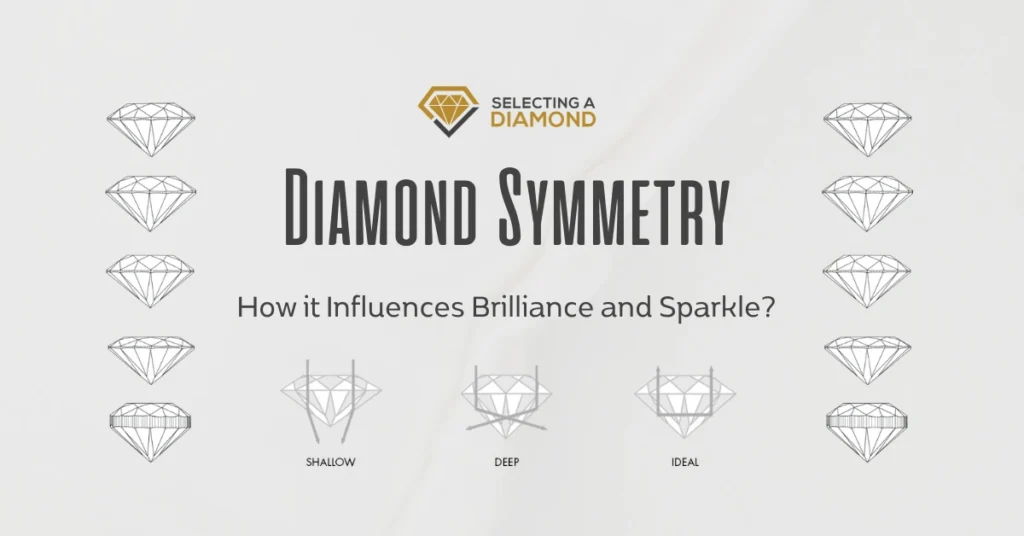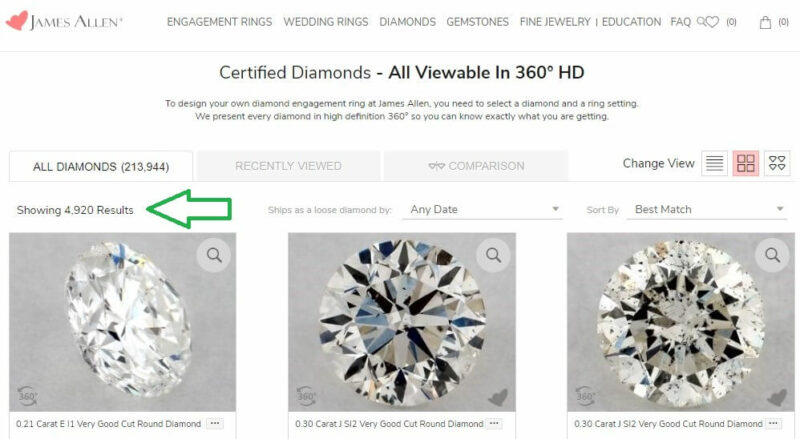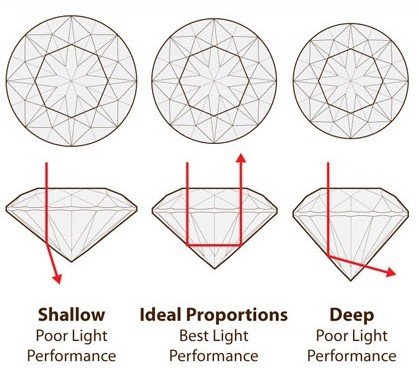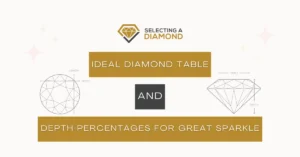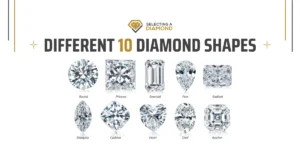We may earn a commission when you purchase through our affiliate links, at no extra cost to you. This helps support our work and allows us to continue providing unbiased, expert diamond advice.
Looking for the perfect diamond can be quite the endeavor. If you’re considering popular retailers like James Allen or Blue Nile, you might notice something interesting when you narrow down your search criteria to diamonds with ‘Good’ symmetry. More often than not, you’ll find that such diamonds are few and far between.
Here’s a simple experiment you can conduct on James Allen.
Initiate a search with no limitations on color, clarity, carat, or cut. The only filter?
Good symmetry.
At the time of writing this article, you’re likely to encounter roughly 5000 diamonds that fit this criterion. However, the moment you exclude diamonds with an Ideal cut or the True Hearts™ cut, you’re left with virtually no results.
What’s going on here?
It’s all about diamond symmetry, good symmetry and an excellent cut do not blend well together.
What is Diamond Symmetry?
Even though the untrained eye might not be able to discern the level of a diamond’s symmetry without assistance, it plays a crucial role in determining a diamond’s overall appeal, and that’s precisely what we’ll explore in this post.
In simple terms, diamond symmetry refers to the alignment of a diamond’s facets and angles. It’s an essential attribute since a diamond’s brilliance or sparkle is largely determined by how well light refracts through it. Hence, a diamond with superior symmetry will invariably be more dazzling than its counterparts with lesser symmetry.
To gain a deeper understanding of symmetry, think back to your math classes in school. Symmetry, in mathematics, denotes that an object is identical across both halves when split down the middle.
Consider the image below to comprehend why symmetry in diamonds is of utmost importance.
Symmetry Impact on Diamond Cut & Brilliance
The path of light within a diamond is the key to understanding the pivotal role that symmetry plays in a diamond’s overall brilliance. When a diamond boasts excellent symmetry, each facet and angle meticulously aligns to guide light in a particular direction, creating a mesmerizing display of sparkle.
However, this carefully orchestrated dance of light can go awry in a diamond with poor symmetry. In such a scenario, facets that should ideally mirror each other diverge in their angles, causing the incoming light to veer off its prescribed path and ricochet into unintended angles within the diamond.
This mismanagement of light not only disrupts the internal light play but significantly diminishes the diamond’s innate sparkle. In simpler terms, poor symmetry can turn a potential star performer into a lackluster stone.
Thus, symmetry does not just play a superficial role in a diamond’s aesthetics; it is fundamentally intertwined with a diamond’s ability to capture and reflect light, which is the very essence of its allure. The symmetrical harmony of a diamond ensures that light, once captured, is optimally utilized to produce that much-sought-after shimmer, setting the stage for a brilliant spectacle.
Diamond Symmetry Grading Scale
Symmetry grading is a crucial aspect of diamond evaluation, as conducted by the Gemological Institute of America (GIA).
The GIA grades diamond symmetry under 10x magnification, a standard level of magnification using a jeweler’s loupe. The grades range from Excellent, Very Good, Good, Fair, to Poor.
The symmetry grade of a diamond is determined by the visibility and presence of symmetrical deviations. Several factors are considered during this evaluation, such as:
- The size and shape of the diamond facets.
- The alignment of the crown and pavilion facets.
- The placement of the culet in relation to the table.
- The existence of any missing or extra facets.
- Variation in the thickness of the diamond’s girdle.
- The centration of the table.
Let’s break down what each grade entails:
- Excellent: Diamonds graded as Excellent in symmetry show no or very minimal deviations. Their facets are perfectly shaped and aligned, tables are centered, and there are no missing or extra facets.
- Very Good: Diamonds with Very Good symmetry have minimal deviations that are “extremely” difficult to spot, such as slight misalignment or slightly misshapen facets.
- Good: Diamonds with Good symmetry showcase a few more deviations. These minor discrepancies, such as variations in the pavilion angle or a missing facet, can somewhat impact the diamond’s brilliance.
- Fair: Fair symmetry diamonds exhibit several noticeable deviations. These irregularities, including misalignments, variations in facets, and misshapen features, can impair the diamond’s brilliance to an extent that might be visible even to the naked eye.
- Poor: Diamonds with Poor symmetry have numerous and obvious deviations. These could range from an off-center table, misshapen or missing facets, to notable variations in facet alignment and shape. Such diamonds are likely to look dull due to the mismanagement of light within the stone.
Through this grading scale, the GIA provides a comprehensive evaluation of a diamond’s symmetry, ensuring that you have all the information you need to make an informed purchase.
What Diamond Symmetry to Look For?
When it comes to buying a diamond, aiming for an excellent symmetry grade is an ideal strategy, given the critical role symmetry plays in the overall aesthetic appeal of the stone.
Symmetry, essentially, affects the path of light traveling through the diamond, and therefore its brilliance. An excellently symmetrical diamond optimizes the reflection and refraction of light, thereby ensuring maximum sparkle and fire.
Conversely, a diamond with merely good symmetry can display noticeable deviations, which could potentially distort how light moves within the diamond, leading to a reduction in its overall brilliance and sparkle.
A diamond with an excellent cut grade offers superior brightness, fire, and scintillation, contributing to its eye-catching allure. Choosing a diamond with an excellent symmetry grade not only enhances these effects but also maximizes the stone’s aesthetic potential.
Although diamonds with good symmetry may offer a budget-friendly alternative, it’s important to remember that the potential compromise on brilliance may be more apparent, particularly in larger diamonds. In smaller diamonds (under 1 carat), these deviations may be less perceptible, but the overall sparkle could still be slightly compromised.
Should I Buy a Diamond Based on its Symmetry?
The answer is NO.
While symmetry plays a crucial role in determining the overall brilliance of a diamond, it should not be the sole factor dictating your purchasing decision. The quality of a diamond is largely influenced by the 4Cs:
Carat, Cut, Color, and Clarity.
Therefore, it’s imperative to educate yourself on these aspects before setting out to buy a diamond, whether in a brick-and-mortar store or our preferred way online. The primary consideration should always be the quality defined by the 4Cs, with symmetry serving as an additional criterion for fine-tuning your selection.
We highly recommend online diamond retailers like James Allen and Blue Nile. They offer vast collections of diamonds and user-friendly platforms that allow you to compare and filter diamonds based on their individual characteristics, aligning with your personal preferences and budget. This ensures you get the best value for your money, all while choosing a diamond that truly reflects your taste and expectations.
Summary
In the quest for the perfect diamond, symmetry plays a critical role, impacting a diamond’s overall sparkle and appeal.
A diamond’s symmetry is related to the alignment of its facets and angles, dictating how light refracts within it and thus, its brilliance. Good symmetry is rare to find alongside an excellent cut, yet achieving this pairing can elevate a diamond’s beauty to its peak.
Symmetry grades by GIA range from Excellent to Poor, with each grade reflecting the quality of a diamond’s facets, alignment, and light reflection.
While symmetry is crucial, remember that the quality of a diamond is largely dictated by the 4Cs—Carat, Cut, Color, and Clarity. Therefore, it should be part of your purchasing decision, but not the sole determining factor.
Still not sure where to buy your diamond?
We always recommend shopping diamonds online and created a Full guide to shop diamonds like a Pro.
Among online retailers, here are our favorite stores click their logo to visit store
-
James Allen:
Our favorite online store, best diamond imaging technology available today, comes with the largest collection with more than half a million loose diamonds.
-
Blue Nile:
Widest collection of loose diamonds of all sizes, great imaging technology for most of their inventory (hundreds of thousands of diamonds), great customer support.
-
Whiteflash:
Home Of A CUT ABOVE® Super Ideal Diamonds, they stand out from the crowd by offering premium diamonds cuts, tailored to those who love the details, at great prices too.

